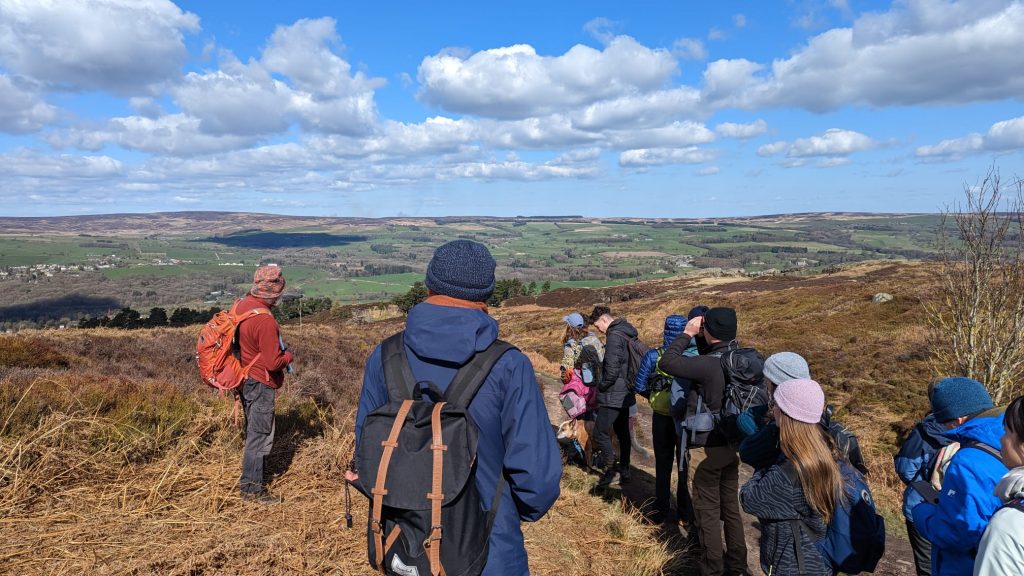Grouse Moor Management: Balancing Conservation and Tradition
This year, I spent my 27th birthday with my classmates, trudging through mud, heather, and grouse droppings on top of a windswept Ilkley Moor.

Many of you will recognise Ilkley Moor as the inspiration behind Yorkshire’s county anthem, On Ilkla Moor Baht ‘at, but to those of us studying at the University of Leeds, we know it has the closest place to go to feel as if we’re far out of the city and completely surrounded by nature.
The lyrics, On Ilkla Moor Baht ‘at, Tha’s bahn’ to catch thy deeath o’ cowd (On Ilkley Moor without a hat, You’re bound to catch your death of cold), must have scared us, as we all came wrapped up in too many layers, voicing surprise as the sun shone and layers were quickly removed and stuffed into backpacks.
We were guided through the moorland by Tim Kohler, a Senior Reserve Manager for Natural England, whose knowledge of nature conservation (particularly within urban areas) is astounding and comes from decades of experience. During the course of the day, Tim concentrated most of the discussions on the controversial management practices that currently take place there.
Like many moorlands in the UK, Ilkley Moor is managed for grouse shooting, a technique that often polarizes opinions. The impacts of grouse moor management on biodiversity are complex and nuanced, with compelling arguments on both sides of the debate, arguments that Tim shared with us throughout the day, and that I’d like to summarise here for those of you interested.
Benefits of Managing Moorland for Grouse Shooting
Prescribed burning
Prescribed burning, a method used in grouse moor management to help maintain the heather-dominated habitat preferred by red grouse, can have several benefits to the ecosystem as a whole.
It can prevent the encroachment of woody vegetation, maintaining heather as a food source for grouse, as well as for other moorland bird species, such as golden plover and curlew.
It can also create structural variation in the landscape, with areas of different heather ages and heights, patches of bare ground, and areas of regenerating heather. This can create a mosaic of habitats that benefit a range of wildlife, providing diverse nesting, breeding, and foraging opportunities.

Regular burning can also prevent the build-up of excessive fuel loads and reduce the risk of catastrophic wildfires that can destroy large areas of heather moorland, with potential impacts on wildlife populations.
Economic value
Supporters of grouse moor management argue that it is the best way to maintain the economic and environmental value of upland moorlands.
Without this management technique, these habitats are often difficult to graze and can quickly progress into woodland, potentially leading to a national decline in this habitat type. Maintaining this technique can contribute to the local economy, support local jobs, and provide incentives for landowners to manage their land for conservation purposes.
Peatland conservation
Sustainable grouse moor management practices can include measures to protect and restore peatlands, which are important for carbon storage, water regulation, and biodiversity. This can involve reducing the risk of wildfires that can degrade peatlands, as well as preventing damage from intensive burning practices.
Grouse moorland management can also involve controlling water levels on peatlands, which can help to prevent erosion and degradation of peat, and maintain the hydrological functioning of the peatland ecosystem. This can help to preserve the unique ecological characteristics of peatlands, which are important habitats for many species.
Wheear ‘ast tha bin sin’ ah saw thee?
– Excerpt from On Ilkla Mooar baht ‘at (Yorkshire dialect)
On Ilkla Mooar baht ‘at
Tha’s been a cooartin’ Mary Jane
Tha’s bahn’ to catch thy deeath o’ cowd
Then us’ll ha’ to bury thee
Drawbacks of Managing Moorland for Grouse Shooting
Intensive burning
If prescribed burning is carried out too frequently or at the wrong time of year, it can lead to a loss of heather cover and other vegetation, which can negatively impact a variety of species that rely on heather-dominated habitats for nesting, foraging, and cover.
Intensive burning can fragment habitat patches and disrupt wildlife movement patterns. This can limit dispersal of species, reduce genetic connectivity, and disrupt ecosystem dynamics.
Fragmentation of habitat can also lead to edge effects, such as increased predation, changes in microclimate, and altered species composition at habitat edges, which can have negative impacts on biodiversity.
Although prescribed burning can have a positive impact on wildfire frequency and severity if properly controlled, this management technique can have a negative impact if burns are not carried out properly or are conducted under unfavorable weather conditions.
As well as the resulting loss of vegetation, and the threat to wildlife populations, wildfires may also result in a loss of infrastructure and property, and pose risks to human safety. In the case of Ilkley Moor, important archeological sites and artifacts may also be damaged in the process.

Raptor persecution
Grouse moor management is often associated with the illegal persecution of protected wildlife species, including raptors such as hen harriers, golden eagles, and peregrine falcons, which are seen as potential threats to grouse populations.
The illegal killing of protected wildlife on grouse moors can have severe ecological impacts, including local extirpation or declines in populations of these species, disrupting ecosystem dynamics and functioning.
Most of us are aware of this issue and it is one that I have felt we are powerless against in the past. However, speaking to those at the forefront of the battle and hearing about the progress being made has me feeling hopeful for the future.
It is also important to note that raptor protection is being fought for by landowners more and more as the years go on and conservation education increases. Plus, it is likely a small number of grouse shooters and landowners that partake in this illegal activity, giving the sport as a whole an (arguably undeserved) bad name.
Medicated grit
The use of medicated grit as a parasite control measure on grouse moors can have unintended consequences on non-target species. The distribution of medicated grit can result in the ingestion of potentially harmful substances by other birds and invertebrates, as well as scavengers and other predators that feed on contaminated prey.
Although landowners are advised to place medicated grit in trays to minimize spread, this recommendation is often overlooked, as evident in my photo from Ilkley Moor.

Peatland degradation
In some cases, moorland management for grouse shooting may involve the drainage of peatlands to increase the availability of suitable habitat for grouse.
Burning and draining of peatland – which is sometimes conducted in unsustainably managed grouse moorlands – can release greenhouse gases, such as carbon dioxide and methane, into the atmosphere.
Peatlands are important carbon sinks and their degradation can contribute to climate change. Burning can also release other air pollutants, such as particulate matter and nitrogen compounds, which can have negative impacts on air quality and human health.
It’s important to note that the ecological benefits of grouse moor management are a topic of debate, and not all experts agree on the extent to which these benefits are realized.
Personally, I believe that grouse moors do have a place in Britain. However, it’s essential that management is carried out in accordance with best practices, including appropriate burning regimes, predator control measures that are legal and sustainable, and monitoring of impacts on biodiversity. Conservation efforts should also strive to balance economic and environmental goals, and consider the potential impacts on sensitive species, such as raptors and specialist invertebrates.
Without the effort being taken to keep conservation a priority, grouse shooting should be just another tradition that we’ve rightfully outgrown in Britain.
Wanting to learn more about game management practices and the associated effects on biodiversity? Click here!


